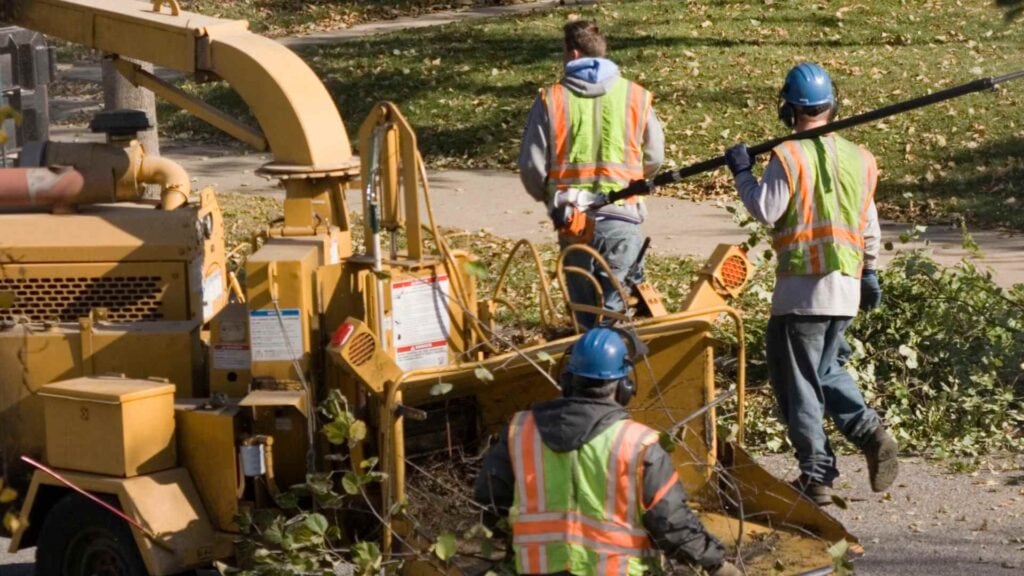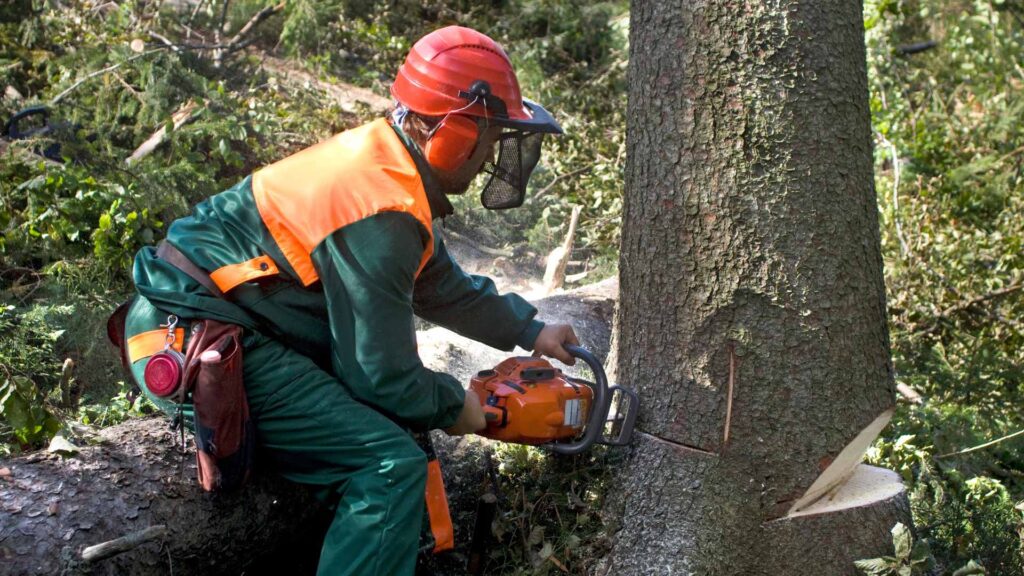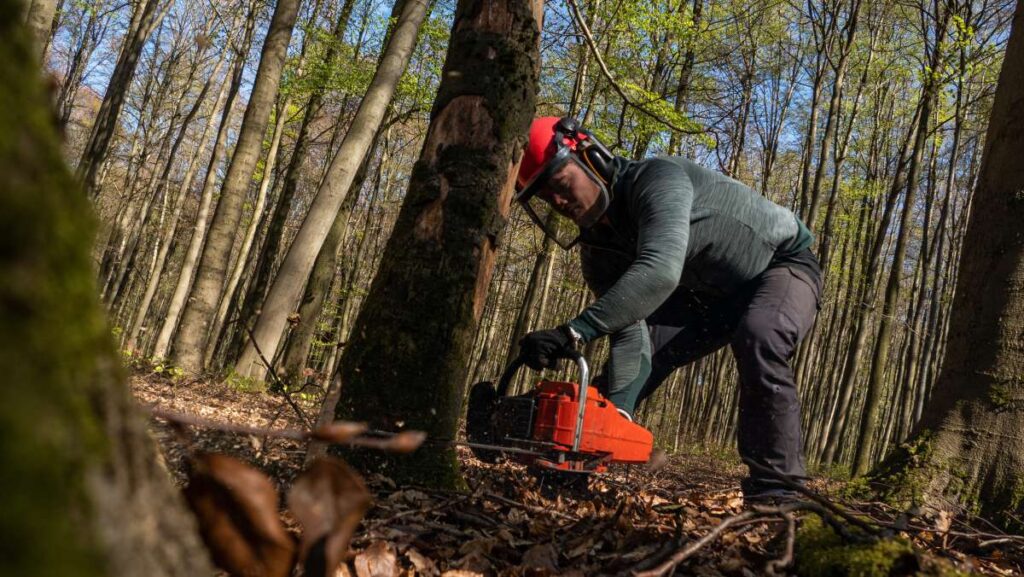The removal of trees is a vital but sometimes dangerous job that calls for meticulous preparation and execution. There are dangers associated with tree removal, despite the fact that sometimes it is necessary for reasons of security, beauty, or property development. If safety measures aren't taken, accidents during tree removal could cause bodily harm or expensive property damage. In order to ensure that the tree removal process is carried out with the utmost concern for safety, this document covers the essential safety precautions to take, both for the people doing the removal and for the people in the surrounding area. Following these safety measures can help you remove trees safely and efficiently.
Why It's Dangerous?
The equipment is the main and foremost source of risk during tree cutting. Tree removal requires the use of potentially lethal power and manual instruments like chainsaws and wood chippers. A chainsaw or an axe can cause catastrophic injury to hands, legs, or arms in a split second if you're not paying attention. The costs of medical care and rehabilitation as a result of this will be significant. Tree workers use the equipment daily and wear protective gear, but they still get harmed on the job. Someone without training or expertise could seriously hurt themselves.
The tree itself poses a significant threat throughout the cutting process. Attempting to cut down a tree exposes workers to a wide variety of hazards. The first problem is that people can get wounded if they fall out of a tree without the right gear. Weak limbs can operate as poor support systems even with the right gear, resulting in accidental falls. The second issue is the potential proximity to power lines. Someone working on a tree near power or telephone lines runs the risk of being electrocuted if they fall backwards towards the lines or make contact with them while using tools.

The tree itself may contain or be a source of danger. Without the right protection, climbing some trees could result in a trip to the emergency room if you encounter any deadly insects or plants. That's why people who operate in tree service always have on sturdy work gloves and other safety gear before climbing. Experts always double-check the safety of the area before cutting down a tree since electricity cables can leak toxic substances onto the foliage.
Dead or rotting timber also poses a significant threat inside the tree. If the tree is dying, its eventual fall could be sudden and dangerous. It can be dangerous to use standard power tools on dead or dying trees due to the hollowed-out trunks and unstable limbs. Using a crane is the most effective—albeit more costly—method for removing a dead tree. If your tree shows any symptoms of decay, have it removed immediately; there's no need to wait until it's completely dead.
Finally, there are risks involved with the actual tree fall. Problems related to trees falling on houses, electricity lines, or people are not always predictable. Expert tree cutters will clear the area, mark the trees to be felled, and then use cables to guide the tree as it falls. Homeowners who do this risk more than just the burden of removing a large tree from their property.
Common Hazards Of Cutting Down Trees
The potential for disaster while felling a tree varies from tree to tree. Therefore, it's important to evaluate the risks before attempting to do it on your own.
Collapsing Branches
Trees are not felled in one fell swoop. The process is sequential. Therefore, the remaining branches must be evaluated carefully to see whether or not they can support the tree's weight.
Tree Falling On You
Despite being one of the most common dangers associated with cutting down trees, few individuals think to watch out for it. If you don't secure the tree properly, it could fall on you.
Falling Tree Limbs
Most people believe that the tree itself will fall on them when they are cutting it down. In actuality, you're more likely to be hurt by a falling tree limb.
Power Lines
Keep in mind the electricity lines while you cut down trees. You should be careful not to disrupt service by breaking lines.
Flying Debris
Depending on your technique, tree branches may scatter in any direction when you cut them. Injury or property damage may result from this flying debris. It's important to be aware of the potential consequences of tree cutting.
Fire Hazards
When you cut down trees, especially pine trees, around your house, the wood might dry out and crack. Because of its dryness, it poses a fire risk after being felled. Therefore, when felling pine trees, cut them low to the ground and let them sit for a few days before removing them. The risks involved with felling trees should be eliminated now that the ground has dried out.
Trees Falling The Wrong Way
Pine trees, in particular, can grow dry and brittle if cut down too close to a house. Due to its dry condition, it poses a risk of starting fires after being felled. If you must fell a pine tree, do so as near to the ground as possible and then wait a few days before carrying it away. The risk of injury from felling trees should now be eliminated thanks to the drying out.
Tumble Hazards
Even after a tree is felled, its remnants—its stump and roots—remain underground. Tripping and falling due to these dangers can result in more severe consequences.
Toxic Fumes
Toxic gases could be released from trees if they are cut down in close proximity to people's homes. Avoid these risks by ensuring adequate ventilation during tree cutting. In particular, you need to take precautions to keep harmful vapours out of your lungs.
Chainsaw Hazards
A chainsaw is a dangerously effective and perhaps lethal equipment in the wrong hands. One of these risks is kickback, which can cause the chainsaw to spin out of control and potentially harm or even kill the user. Power instruments, including chainsaws, are best left in the hands of professionals from a tree removal service.
Important Tips For Safe Tree Removal
Inspect The Tree Thoroughly
Tree removal should never be done unless absolutely necessary. Therefore, a thorough examination is required before making the ultimate choice. When evaluating the tree, keep in mind why you want to chop it down. This could be anything from making more room to concerns about its health. If you follow these steps, you won't accidentally cut down a good tree.
Use The Right Tree Removal Equipment & Protective Gear
Wear protective clothing and equipment such as gloves, a hard hat, a safety vest, goggles, earplugs, and shoes made for the job. The potential for mishaps is thereby diminished. To maximise productivity and reduce setbacks, it is also crucial to employ the appropriate machinery.
Read The Directions For The Equipment Carefully
If you're using a chainsaw or other powerful tool to remove tree branches or stumps, it's a good idea to familiarise yourself with the manufacturer's instructions. Using a chainsaw or other dangerous tool without proper training can be extremely dangerous for the user and people nearby.
Be Aware Of The Tree Removal Don'ts
Tree cutting requires more than just familiarity with tools like chainsaws. It requires thinking about several things, including the tree's health, the environment, the job's physical demands, and more. As a result, it's helpful to be aware of the things you shouldn't do when cutting down a tree, such as climbing a ladder without someone holding the bottom, cutting trees too close to power lines without first checking the area, and so on.
Call An Expert When You Have Doubts

If you are unsure of where to start while removing a tree, it is best to consult with professionals. This is due to the fact that casualties and financial costs could result from even the smallest of errors during the task.
Survey Your Surroundings
Look at what's going on close to the tree. How many homes are there in total? Street parking for automobiles? A major thoroughfare? Is there access to electricity, primarily? The tree must be cleared of any power lines within 10 feet. In order to safeguard the safety of everyone in the vicinity, those power lines must be removed by a qualified professional before the tree may be cut down.
Study The Tree Prior To Removal
There are both large and little trees. There are trees with massive branches and some with little twigs. Different trees bring different difficulties and require different approaches. If you or someone else needs to climb the tree, ensure that the branches can handle the extra weight. It's possible that the tree you're dealing with is considerably bigger than usual and may require dismantling. That calls for selecting a suitable location for the task at hand.
Think Like A Meteorologist
There's always that one thing that can derail even the best-laid plans. Weather. In the days or weeks before tree removal, it is highly recommended that you keep an eye on the weather forecast. There is always some element of doubt, but keeping an eye on the forecast can help you avoid potential obstacles.
Use Common Sense
Protective equipment such as gloves, goggles, harnesses, and hard hats should be worn by everyone helping with the removal. Pre-removal testing and maintenance are required for every machinery, from chainsaws to industrial hoists and lifts. While harnessed to a tree, the last thing you need is a faulty chainsaw. Safety equipment is essential, but knowing what to look out for is just as critical. Keep a close eye on your immediate environment, the people who are entering and leaving the area, and the persons who are assisting with the removal.
Getting rid of a tree might involve a lot of steps, as you can see. Various factors can lead to a wide variety of possible outcomes. Experience is invaluable in situations where it is difficult to anticipate every possible obstacle. Many people before you have learned the hard way through trial and error, suffering injuries as a result.
Conclusion
Tree removal is a crucial but potentially dangerous job that requires careful preparation and execution. The equipment used during tree cutting, such as chainsaws and wood chippers, can cause catastrophic injuries and significant medical costs. Tree workers must wear protective gear and be aware of potential hazards, such as falling out of a tree without the right gear, proximity to power lines, and the presence of deadly insects or plants.
Dead or rotting trees also pose a significant threat during the cutting process. Standard power tools on dead or dying trees can be dangerous due to hollowed-out trunks and unstable limbs. Cranes are the most effective method for removing dead trees, and experts should double-check the safety of the area before cutting down a tree.
Common hazards of tree removal include collapsing branches, tree falling on you, falling tree limbs, power lines, flying debris, fire hazards, falling the wrong way, tumble hazards, toxic fumes, and chainsaw hazards. It is essential to evaluate these risks before attempting to remove trees and take necessary precautions to ensure safety and efficiency.
Tree removal should be done only if absolutely necessary, and it is crucial to inspect the tree thoroughly and consider its health concerns. Use appropriate equipment and protective gear, such as gloves, a hard hat, safety vest, goggles, earplugs, and shoes, to minimize potential accidents. Familiarize yourself with the manufacturer's instructions for powerful tools, as improper use can be dangerous. Be aware of tree removal don'ts, such as climbing a ladder without someone holding the bottom or cutting trees too close to power lines. Consult with professionals if unsure of where to start, and survey your surroundings to ensure safety. Study the tree before removal, ensuring the branches can handle the extra weight and selecting a suitable location for the task. Keep an eye on the weather forecast to avoid potential obstacles. Use common sense, including protective equipment, pre-removal testing, and maintenance for machinery. Be aware of your surroundings, people entering and leaving the area, and those assisting with the removal. Experience is invaluable in situations where it is difficult to anticipate every possible obstacle.
Content Summary:
- The removal of trees is a vital but sometimes dangerous job that calls for meticulous preparation and execution.
- There are dangers associated with tree removal, despite the fact that sometimes it is necessary for reasons of security, beauty, or property development.
- If safety measures aren't taken, accidents during tree removal could cause bodily harm or expensive property damage.
- In order to ensure that the tree removal process is carried out with the utmost concern for safety, this document covers the essential safety precautions to take, both for the people doing the removal and for the people in the surrounding area.
- Following these safety measures can help you remove trees safely and efficiently.
- The equipment is the main and foremost source of risk during tree cutting.
- Attempting to cut down a tree exposes workers to a wide variety of hazards.
- The tree itself may contain or be a source of danger.
- That's why people who operate in tree service always have on sturdy work gloves and other safety gear before climbing.
- Experts always double-check the safety of the area before cutting down a tree since electricity cables can leak toxic substances onto the foliage.
- Finally, there are risks involved with the actual tree fall.
- The potential for disaster while felling a tree varies from tree to tree.
- Therefore, it's important to evaluate the risks before attempting to do it on your own.
- Despite being one of the most common dangers associated with cutting down trees, few individuals think to watch out for it.
- If you don't secure the tree properly, it could fall on you.
- In actuality, you're more likely to be hurt by a falling tree limb.
- Keep in mind the electricity lines while you cut down trees.
- It's important to be aware of the potential consequences of tree cutting.
- Pine trees, in particular, can grow dry and brittle if cut down too close to a house.
- Due to its dry condition, it poses a risk of starting fires after being felled.
- If you must fell a pine tree, do so as near to the ground as possible and then wait a few days before carrying it away.
- Avoid these risks by ensuring adequate ventilation during tree cutting.
- Power instruments, including chainsaws, are best left in the hands of professionals from a tree removal service.
- When evaluating the tree, keep in mind why you want to chop it down.
- If you're using a chainsaw or other powerful tool to remove tree branches or stumps, it's a good idea to familiarise yourself with the manufacturer's instructions.
- It requires thinking about several things, including the tree's health, the environment, the job's physical demands, and more.
- As a result, it's helpful to be aware of the things you shouldn't do when cutting down a tree, such as climbing a ladder without someone holding the bottom, cutting trees too close to power lines without first checking the area, and so on.
- If you are unsure of where to start while removing a tree, it is best to consult with professionals.
- Look at what's going on close to the tree.
- The tree must be cleared of any power lines within 10 feet.
- In order to safeguard the safety of everyone in the vicinity, those power lines must be removed by a qualified professional before the tree may be cut down.
- There are both large and little trees.
- If you or someone else needs to climb the tree, ensure that the branches can handle the extra weight.
- It's possible that the tree you're dealing with is considerably bigger than usual and may require dismantling.
- That calls for selecting a suitable location for the task at hand.
- Weather.
- In the days or weeks before tree removal, it is highly recommended that you keep an eye on the weather forecast.
- There is always some element of doubt, but keeping an eye on the forecast can help you avoid potential obstacles.
- While harnessed to a tree, the last thing you need is a faulty chainsaw.
- Safety equipment is essential, but knowing what to look out for is just as critical.
- Keep a close eye on your immediate environment, the people who are entering and leaving the area, and the persons who are assisting with the removal.
- Getting rid of a tree might involve a lot of steps, as you can see.
FAQs About Removing Trees
Safety precautions are essential because tree removal can be a dangerous task. Without proper precautions, there is a risk of accidents, injuries, and property damage. Taking safety measures ensures the well-being of everyone involved and protects the surrounding environment.
Personal protective equipment (PPE) is crucial, including helmets, eye protection, gloves, and chainsaw chaps. Additionally, specialised tree removal tools and machinery, such as chainsaws and rigging equipment, are necessary to safely cut and remove the tree.
Start by evaluating the tree's species, condition, and proximity to structures. If the tree is dead, diseased, leaning dangerously, or poses a threat to property or safety, it may need to be removed. Consulting with a certified arborist is often a good practice.
A tree removal plan should outline the scope of work, safety measures, and emergency procedures. It should detail how the tree will be removed, including cutting and rigging techniques, and specify who is responsible for what tasks.
Hazards include falling branches, unstable trees, electrical lines, and unexpected movement of the tree. Additionally, wildlife and insect infestations in the tree can pose risks. Identifying and mitigating these hazards is crucial.

